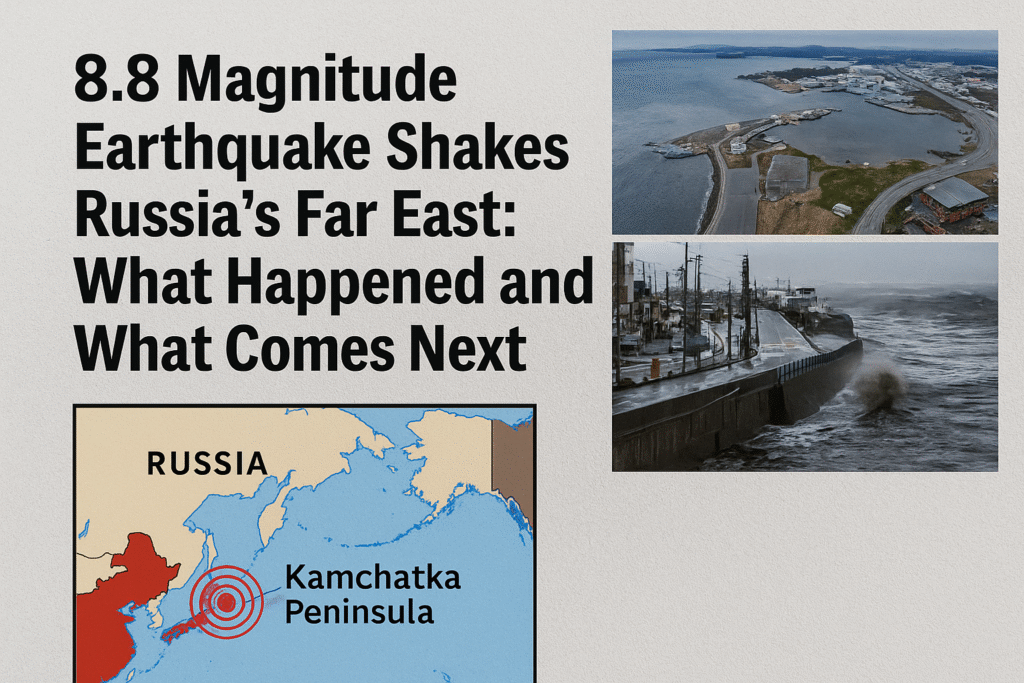Table of Contents
Russia Earthquake 2025: 8.8 Magnitude Quake Hits Far East, Tsunami Alerts Across Pacific
The Russian Far East experienced one of the most powerful earthquakes in recent history — an 8.8 magnitude tremor — triggering tsunami waves across the Pacific region. The seismic jolt, recorded off the Kamchatka Peninsula, has been confirmed as the sixth-largest earthquake ever by the US Geological Survey.
Despite the intensity, preliminary reports indicate minimal damage and no major casualties, but strong tsunami waves were felt across Japan, Hawaii, the US West Coast, and even as far as New Zealand.
Tsunami Alerts Across the Pacific: Global Ripples from One Epicenter
Authorities across Japan, Hawaii, and North America’s Pacific coastline scrambled to issue tsunami warnings shortly after the quake struck.
- In Japan, residents in Hokkaido took shelter on rooftops as strong waves battered the northern coast.
- The US West Coast, including California and Oregon, experienced dangerous rip currents, prompting coastal evacuations and alerts.
- Hawaii reported tsunami activity in Honolulu, with advisories warning swimmers and boaters to stay out of the water.
Did You Know?
The seismic energy released in this 8.8 quake is about 31.6 times greater than the 7.8 quake that devastated Turkey and Syria in 2023.
Russia’s Response: Calm Amid the Quake
Despite the earthquake’s magnitude, Russian officials in Kamchatka reported limited immediate damage. Emergency responders, scientists, and civil defense teams quickly assessed the region.
Hospitals & Infrastructure Withstand Tremors
- Petropavlovsk-Kamchatsky, Kamchatka’s largest city, remained largely operational.
- Emergency teams did not report structural collapses or widespread destruction.
- Power and communications were briefly disrupted but restored quickly.
🌍 Comparing the 2025 Quake With Historic Earthquakes
| Year | Magnitude | Location | Death Toll |
|---|---|---|---|
| 1960 | 9.5 | Chile | 1,600+ |
| 2004 | 9.1 | Indonesia | 227,000+ |
| 2011 | 9.0 | Japan | 18,000+ |
| 2025 | 8.8 | Russia (Far East) | Minimal (TBC) |
While the quake was smaller than Japan’s 2011 catastrophe, it’s considered the most powerful in Russia’s modern recorded history.
Why Kamchatka Is Prone to Big Quakes
Russia’s Kamchatka Peninsula sits on the “Ring of Fire” — a seismically volatile area that circles the Pacific Ocean. This region frequently experiences earthquakes and volcanic eruptions due to tectonic plate collisions.
⚠️ What Made This Quake Different?
- Depth: It occurred at around 33.1 km deep, making it shallow enough to trigger large surface shocks.
- Location: Offshore, which likely prevented catastrophic inland damage.
- Timing & Preparedness: Quick alerts and tsunami protocols likely saved lives across multiple countries.
How Other Countries Reacted
United States (West Coast)
- Issued tsunami advisories from California to Washington State.
- No damage reported, but beachgoers were asked to evacuate.
Japan
- Raised tsunami alert levels in northern cities like Hokkaido.
- Bullet train services were temporarily halted as a safety measure.
New Zealand
- Authorities warned of unusual currents, advising the public to stay away from beaches and harbors.
What’s Next? Monitoring, Preparedness & Global Lessons
This earthquake is a wake-up call for countries across the Pacific Rim. Even with modern detection systems, nature’s unpredictability remains. Nations with vulnerable coastlines must invest more in:
- Early warning systems
- Disaster education
- Evacuation infrastructure
🌍 Preparedness is the key to survival. Russia’s Far East may have avoided disaster this time — but the Earth never sleeps.
Frequently Asked Questions (FAQs)
Q1: Was this earthquake felt across the world?
Direct shaking wasn’t global, but its tsunami waves and energy ripples affected many countries in the Pacific region.
Q2: Is it safe to travel to Russia’s Far East right now?
According to Russian officials, no major tourist infrastructure was damaged. Travel is being monitored closely by local authorities.
Q3: Could aftershocks still occur?
Yes, scientists warn of potential aftershocks, though none are expected to be as strong as the main quake.
Q4: Why didn’t this cause massive destruction like the 2011 Japan quake?
The offshore epicenter, early warning systems, and improved infrastructure helped minimize damage and casualties.
